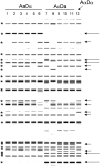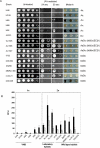Many globally isolated AD hybrid strains of Cryptococcus neoformans originated in Africa
- PMID: 17708680
- PMCID: PMC1949410
- DOI: 10.1371/journal.ppat.0030114
Many globally isolated AD hybrid strains of Cryptococcus neoformans originated in Africa
Abstract
Interspecific and intervarietal hybridization may contribute to the biological diversity of fungal populations. Cryptococcus neoformans is a pathogenic yeast and the most common fungal cause of meningitis in patients with AIDS. Most patients are infected with either of the two varieties of C. neoformans, designated as serotype A (C. neoformans var. grubii) or serotype D (C. neoformans var. neoformans). In addition, serotype AD strains, which are hybrids of these two varieties, are commonly isolated from clinical and environmental samples. While most isolates of serotype A and serotype D are haploid, AD strains are diploid or aneuploid, and contain two sets of chromosomes and two mating type alleles, MATa and MATalpha, one from each of the serotypes. The global population of serotype A is dominated by isolates with the MATalpha mating type (Aalpha); however, about half of the globally analyzed AD strains possess the extremely rare serotype A MATa allele (Aa). We previously described an unusual population of serotype A in Botswana, in which 25% of the strains contain the rare MATa allele. Here we utilized two methods, phylogenetic analysis of three genes and genotyping by scoring amplified fragment length polymorphisms, and discovered that AD hybrid strains possessing the rare serotype A MATa allele (genotype AaDalpha) cluster with isolates of serotype A from Botswana, whereas AD hybrids that possess the MATalpha serotype A allele (AalphaDa and AalphaDalpha) cluster with cosmopolitan isolates of serotype A. We also determined that AD hybrid strains are more resistant to UV irradiation than haploid serotype A strains from Botswana. These findings support two hypotheses: (i) AaDalpha strains originated in sub-Saharan Africa from a cross between strains of serotypes A and D; and (ii) this fusion produced hybrid strains with increased fitness, enabling the Botswanan serotype A MATa genome, which is otherwise geographically restricted, to survive, emigrate, and propagate throughout the world.
Conflict of interest statement
Figures




References
-
- Arnold ML, Hodges SA. Are natural hybrids fit or unfit relative to their parents? Trends Ecol Evol. 1995;10:67–71. - PubMed
-
- Seehausen O. Hybridization and adaptive radiation. Trends Ecol Evol. 2004;19:198–207. - PubMed
-
- Brasier C. The rise of the hybrid fungi. Nature. 2000;405:134–135. - PubMed
-
- Brasier CM, Kirk SA, Delcan J, Cooke DEL, Jung T, et al. Phytophthora alni sp. nov. and its variants: Designation of emerging heteroploid hybrid pathogens spreading on Alnus trees. Mycol Res. 2004;108:1172–1184. - PubMed
-
- Moon CD, Craven KD, Leuchtmann A, Clement SL, Schardl CL. Prevalence of interspecific hybrids amongst asexual fungal endophytes of grasses. Mol Ecol. 2004;13:1455–1467. - PubMed
Publication types
MeSH terms
Substances
Associated data
- Actions
- Actions
- Actions
- Actions
- Actions
- Actions
- Actions
- Actions
- Actions
- Actions
- Actions
- Actions
- Actions
- Actions
- Actions
- Actions
- Actions
- Actions
- Actions
- Actions
- Actions
- Actions
- Actions
- Actions
- Actions
- Actions
- Actions
- Actions
- Actions
- Actions
- Actions
- Actions
- Actions
- Actions
- Actions
- Actions
- Actions
- Actions
- Actions
- Actions
- Actions
- Actions
- Actions
- Actions
- Actions
- Actions
- Actions
- Actions
- Actions
- Actions
- Actions
- Actions
- Actions
- Actions
- Actions
- Actions
- Actions
- Actions
- Actions
- Actions
- Actions
- Actions
- Actions
- Actions
- Actions
- Actions
- Actions
- Actions
- Actions
- Actions
- Actions
- Actions
- Actions
- Actions
- Actions
- Actions
- Actions
- Actions
- Actions
- Actions
- Actions
- Actions
- Actions
- Actions
- Actions
- Actions
- Actions
- Actions
- Actions
- Actions
- Actions
- Actions
- Actions
- Actions
- Actions
- Actions
- Actions
- Actions
- Actions
- Actions
- Actions
- Actions
- Actions
- Actions
- Actions
- Actions
- Actions
- Actions
- Actions
- Actions
- Actions
- Actions
- Actions
- Actions
- Actions
- Actions
- Actions
- Actions
- Actions
- Actions
- Actions
- Actions
- Actions
- Actions
- Actions
- Actions
- Actions
- Actions
- Actions
- Actions
- Actions
- Actions
- Actions
- Actions
- Actions
- Actions
- Actions
- Actions
- Actions
- Actions
- Actions
- Actions
- Actions
- Actions
- Actions
- Actions
- Actions
- Actions
- Actions
- Actions
- Actions
- Actions
- Actions
- Actions
- Actions
- Actions
- Actions
- Actions
- Actions
- Actions
- Actions
- Actions
- Actions
- Actions
- Actions
- Actions
- Actions
- Actions
- Actions
- Actions
- Actions
- Actions
- Actions
- Actions
Grants and funding
LinkOut - more resources
Full Text Sources

